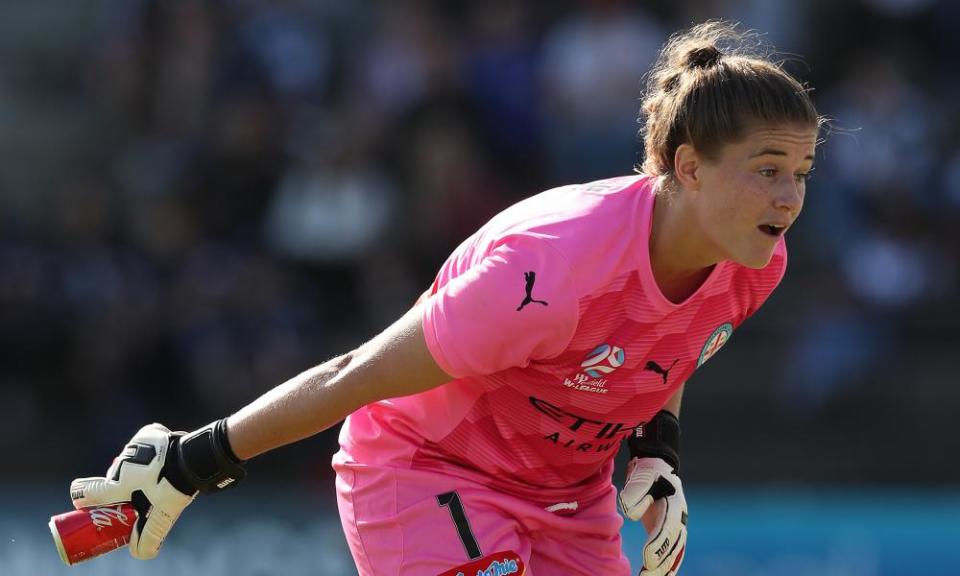W-League's culture placed under threat after men throw bottles onto pitch

Sunday afternoon’s Melbourne derby had everything you could want from a revenge story. The protagonist, Melbourne City, had suffered a great loss the week before. Their 6-0 defeat at the hands of Victory in the first fixture – the biggest in City’s history – was the kind of moment that leads to some existential reckoning; a slow close-up of the bruised and bloodied face of our hero, accompanied by melancholy strings.
But that is always the beginning of the plot. At some point, they must climb out of that deep pit of despair and seek justice for the wrongs inflicted upon them. And that is exactly what City did. Their 3-2 win over Victory had all the subplots and spin-offs you could ask for: the triumphant return of Alex Chidiac from Spain, the growing influence of teenage star Kyra Cooney-Cross, the inspired performance of Matildas goalkeeper Teagan Micah, and City arresting a potentially fatal slide into mediocrity to keep their state-based rivalry alive.
Related: W-League poised for new emerging dynasties in post-Melbourne City era | Samantha Lewis
You won’t read about that this week, though. Instead, the thrilling narrative of this season’s back-to-back Melbourne derbies has been overshadowed by the actions of a minority of Melbourne Victory fans who, in the 87th minute, threw projectiles and abuse at Micah, standing metres away from them while doing her job. This included, alarmingly, a glass bottle, which Micah was forced to pick up and move to the sideline.
The referee, to her credit, paused the game and requested security to investigate the issue. Players from both teams, including Victory captain Angie Beard, addressed the group from the field. Several minutes ticked by, at which point all the momentum and energy of the game had evaporated and the evening’s headlines were hastily rewritten.
It was a particularly frustrating note to end on given these same fans had helped build the electric atmosphere inside the small, suburban Epping Stadium over the previous 86 minutes. They unfurled banners and started chants to energise their players and pump up the 1,000-strong home crowd. Their wild celebrations after each of Victory’s two goals were captured by the cameras and beamed around the world. It was a brilliant advertisement for the W-League and proof of the appeal of smaller, more intimate venues in both match-day experiences and as a television spectacle (particularly in contrast to the silent, near-empty ANZ stadium that hosted the women’s Sydney derby a day earlier).
But the 87th minute on Sunday was a tipping-point; a point at which the two worlds of men’s and women’s active fan culture collided.
Much like the women’s game itself, women’s football fan groups are flourishing on the periphery of the mainstream (men’s) ecosystem. Over the last few years, the W-League has seen a number of women’s-specific fan groups emerge including the Victory Vikings, the Roar Corps, Sydney FC Women and the Newcastle Jets Active. With little to no support from either clubs or men’s active fan groups, women-led groups have slowly organised themselves, introducing the kind of atmosphere to women’s games that have been part of the fabric of men’s football for decades.
But the culture that women’s active fan groups have helped create is fundamentally different from that in the men’s game. By virtue of its different demographic make-up – primarily women, queer people and young families – women’s football has become a space largely free from the toxic language and behaviours, often filled with homophobia, sexism and racism, that can tarnish men’s active fan groups and damage the game’s broader image.
It was this vibrant, safe, inclusive culture was put at risk in the 87th minute on Sunday afternoon. And while the male fans who threw projectiles may have been in the minority, those decisions grew out of a culture where such behaviours are normalised – even expected – as a display of “legitimate” sport fandom; an aggressive, macho performativity that can make men’s active groups feel unsafe and unwelcoming for many other fans.
This is why, as the women’s game grows, its organic fan culture needs protecting. As clubs and leagues increasingly encourage men’s football fans to get involved with the women’s game, whether through targeted advertising or the staging of double-headers, they risk overshadowing and de-legitimising the vibrant community that already exists within it.
For example, while Sunday’s group of male fans were commended up until the projectile-throwing incident, they also completely drowned out the Victory Vikings who had set up banners and drums nearby for the entire game – the same women’s-specific group who, in another glaring juxtaposition, had recently pledged to donate $50 to Beyond Blue for every clean sheet kept by Victory’s women’s team.
The idea that women’s football fan culture (and, indeed, women’s football) needs to mirror the men’s game in order to be valid or valuable in its own right ought to be questioned. The W-League is not the A-League’s little sister, nor are its women-specific fan groups derivatives of their male counterparts. Women’s football has its own history, its own culture and its own community. It’s time the rest of the game respected that instead of trying to replace it.

 Yahoo Finance
Yahoo Finance 